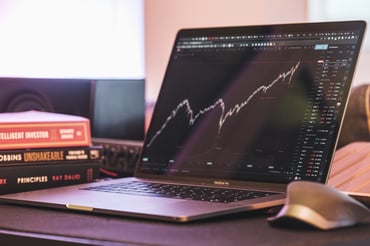The third in HYPE's series on the ten most-often-asked questions about strategic foresight, this post offers guidance, practical tips, and examples of how to build future-proof strategies.
Usually, a strategy boils down to four elements: a vision, strategic goals, strategic choices, and key means of execution (e.g., strategic initiatives or must-wins). Foresight can support strategy creation for all these elements, as well as the execution itself.
Strategy building is about answering the questions of where to play and how to win. According to Dr. Joseph Voros, expert of Strategic Foresight at Swinburne Business School, foresight informs strategy creation by enhancing “the context within which strategy is developed, planned, and executed.” Thus, a "good" strategy informed by foresight should put a company ahead of trends, rest on privileged insights, and embrace uncertainty.
Here’s how foresight can inspire vision, guide goal-setting, inform strategic choices, fuel execution, and provide a sounding board for the execution follow-up.
Foresight inspires vision
A vision states what a company wants to become. It may reflect many different types of aspirations, such as market position, impact, and/or internal transformation. A vision is set for the future, typically describing what we want to be by the end of our strategy period. Often, a vision statement is bold, compelling, and inspirational.
Foresight can inspire the creation of a vision with different signals that can be scouted and interpreted. Strategy-related foresight activities are most likely revolving around some sort of “the future of” (the future of energy, work, transportation, etc.). Within this scope – “the future of X” – trends, phenomena, weak signals, and uncertainties, as well as forerunners toward “the future of X,” are being identified, interpreted, and translated to alternative views of the future.
All this can inspire us and stretch how we think about what we become, how we renew ourselves, how we impact the broader society, and how we change the game in the market. For example, investigating trends of sustainability and meaningful work could inspire a vision that puts the planet and the people at the center of what we want to be in the future.
Foresight guides goal-setting
Strategic goals make the vision more tangible and outline the plans in terms of people (e.g., empowering them), customers, operations, social impact, and sustainability, and, ultimately, numbers. Goals, more specific targets, and measures set the stage for how ambitious we want to be as well as how we follow-up and measure progress. When setting goals, start with identifying goals that, once achieved, would drive the most growth and profitability – the usual suspects on the financial side. The numbers are a result, meaning that they will follow once other strategic goals are driving you in the right direction.
"Foresight helps in finding the right goals as it sheds light on how the company’s operating environment could change..."
The attractiveness of the operating environment, available resources, and different stakeholders all influence goal-setting. Foresight helps in finding the right goals as it sheds light on how the company’s operating environment could change, as well as resource availability and expectations from different stakeholders (from political, economic, ecological, societal, legislative, and technological point of views).
Consider, for example, the growing trend of purposeful capitalism and how it influences goal-setting. Recently, over 180 of North America’s largest companies represented in the Business Roundtable signed the revised Statement on the Purpose of a Corporation. This outlines that instead of serving one stakeholder (shareholders and the goal of profit maximization), companies serve several stakeholders and should commit to delivering value to all of them.
Those companies early enough to recognize the growing trend of purposeful capitalism, and the ways of creating value beyond profit maximization, have had a significant head start to this new normal. Others are still learning to bring the voices of their different stakeholders to goal-setting and, ultimately, to their operations.
Foresight informs strategic choices
Strategic choices refine what we do and don't do to reach our vision and strategic goals. They are often hard-to-reverse decisions related to where we play (e.g., markets and customer segments), how we win (e.g., our competitive advantages), and where we innovate (e.g., strategic innovation areas). In execution, strategic choices will guide attention, resource allocation, and everyday decision-making so that efforts are put to areas according to the focus.
One should always develop and weigh alternatives when making choices. Regarding market and customer choices, one can use foresight to identify emerging new markets and transitions in established markets ahead of the competition and to work out their conclusions to all things related to execution (e.g., capability, organization, and business model development).
Individual trends can be leveraged as demand drivers to find markets and customer segments that are growing or declining and, thus, determine the strategic innovation areas. For example, the phenomena of the sharing economy and leasing instead of buying most likely creates demand for equipment and tool rental companies, among others.
Scenarios – alternative views of the future – can support the timing of the choices as well as the efforts needed for those choices to succeed. For example, creating scenarios around the adoption of electric vehicles (slow to rapid) can support companies in the electric mobility industry in deciding when and how much to invest in development as well as prepare for the possible changes in the pace of adoption early on.
Foresight fuels execution planning
Usually, execution planning is a one-off activity following strategy creation. Plans of equal length to the strategy period are created once a vision, strategic goals, and strategic choices start to take shape. The key, however, is not to have static plans but to do continuous planning around areas, e.g., strategic innovation areas that are most important for the successful execution of the strategy. Oftenu, those development areas are called strategic initiatives or must-wins. The focus of the strategic initiatives should be on the organization-level capability development (e.g., processes, governance, competencies, tools, and technologies) instead of individual development actions.
Why? Focusing on capability development provides the organization with overarching priorities as well as direction for the development while leaving room and flexibility for more specific actions and experiments.
Here, scenarios and understanding of the possible development trajectories of trends can again help set the priorities for execution and capability development, especially in terms of innovation. For example, with technology adoption, Gartner’s Hype Cycle of Emerging Technologies offers a point of reference for prioritization and timing technology development and/or implementation actions. Technological innovations can help to differentiate from the competition; the key is to have the timing right from the market perspective. As with choices, alternative views of the future can prepare the organization to change direction flexibly, if needed.
Foresight provides a sounding board for execution follow-up
There are two critical questions related to the follow-up of the strategy execution. The first question – are we on the right track? – refers to the strategic direction: vision, strategic goals, and strategic choices. The second question – are we focusing on the right things in terms of execution? – refers to the execution priorities and their timing. These two questions should help in differentiating whether we need to reconsider our focus regarding our strategic direction and/or efforts put to execution if the goals aren't met.
All things strategy – the vision, goals, choices, and execution – are laden with assumptions, and these assumptions should be revealed before foresight can provide a sounding board for the execution follow-up. While making choices, the markets, demand, customer behavior, etc., are assumed to develop in one way or another.
While planning for execution, technologies are forecasted to develop and to be deployed at one time or another. Most often, these assumptions are not explicit, and, when this is the case, the assessment of the validity of the assumptions becomes difficult. Hence, before foresight can offer a sounding board for the execution follow-up, the first step is to clarify the assumptions underlying the strategy building.
Once the assumptions are explicit, their validity can be discussed and monitored. For example, a set of indicators can be developed that correspond to the key assumptions behind our strategy (e.g., market development, technological development, competition, political landscape) and these indicators can be monitored at frequent intervals to answer to the questions of are we on the right track and are we focusing on the right things in terms of execution.
To close, foresight has an enormous potential in strategy building – to inspire vision, guide goal-setting, inform strategic choices, fuel execution, and provide a sounding board for the execution follow-up. When an organization uses foresight rigorously, it can put a company ahead of trends and make strategies better by resting them on privileged insights and enable them to embrace uncertainty. Are you utilizing foresight to its fullest potential to future-proof your strategy?
--
For software support, check out HYPE Strategy - Discover the gaps in your strategy and identify the trends, technologies, and organizations that can fill them.










